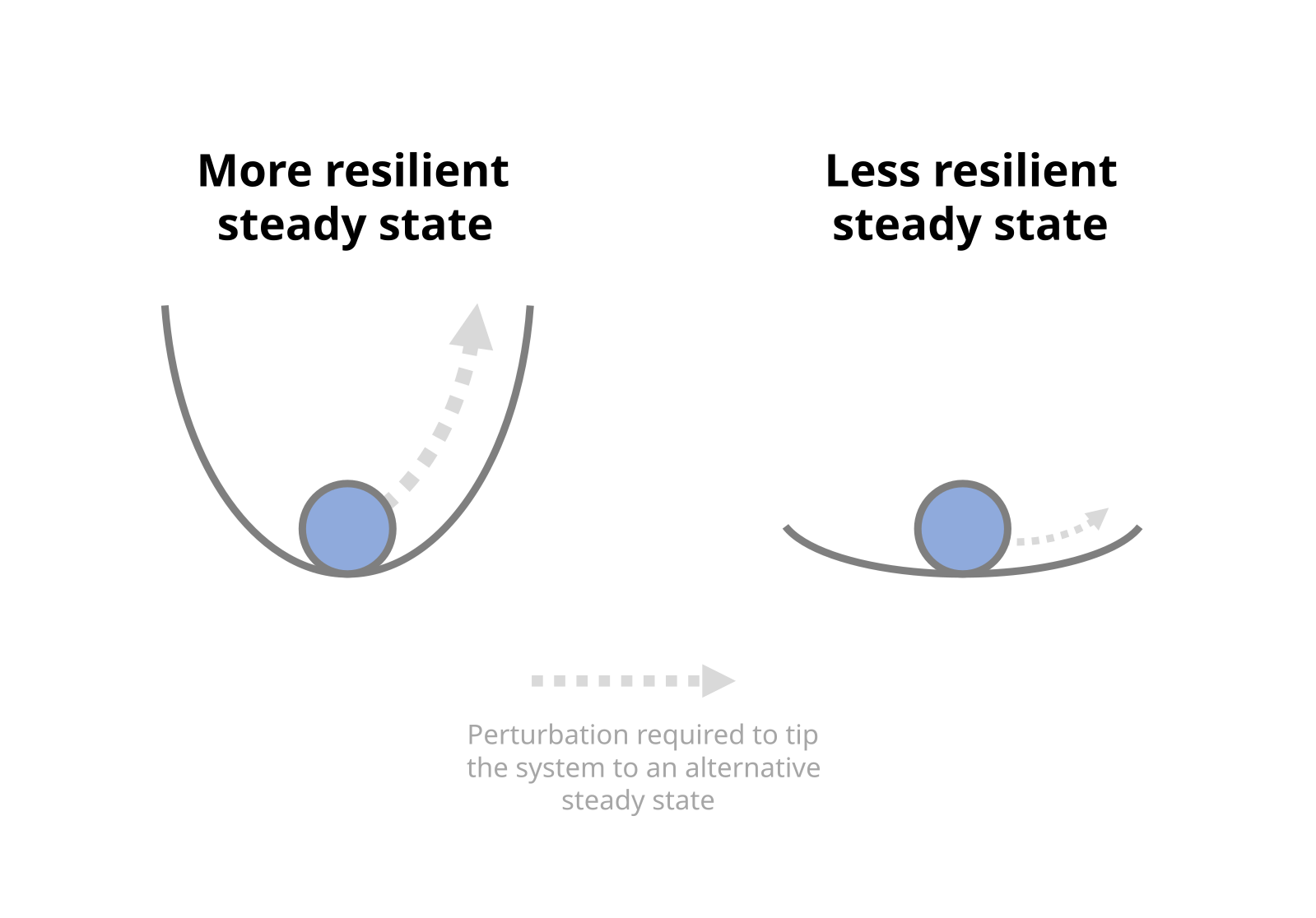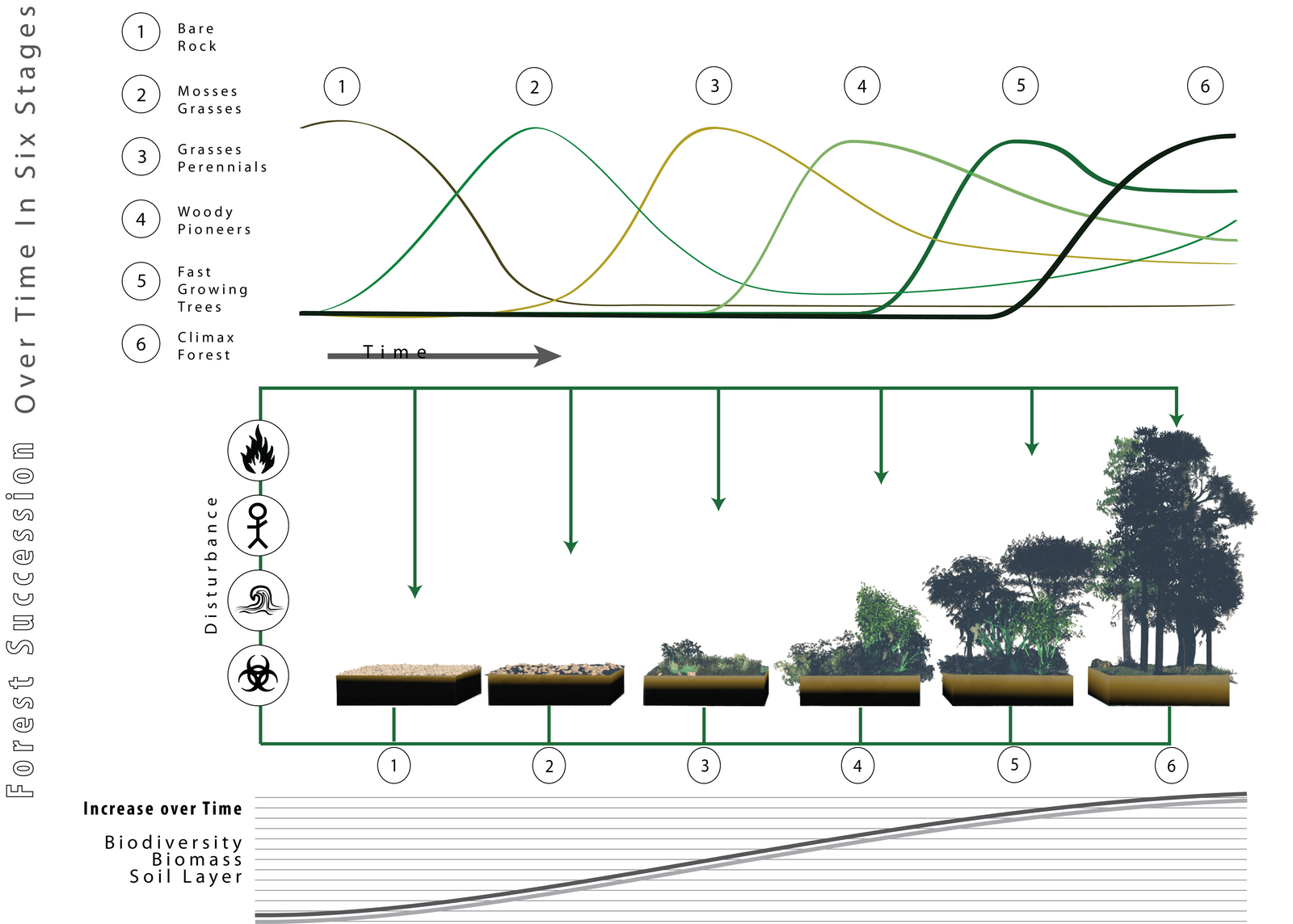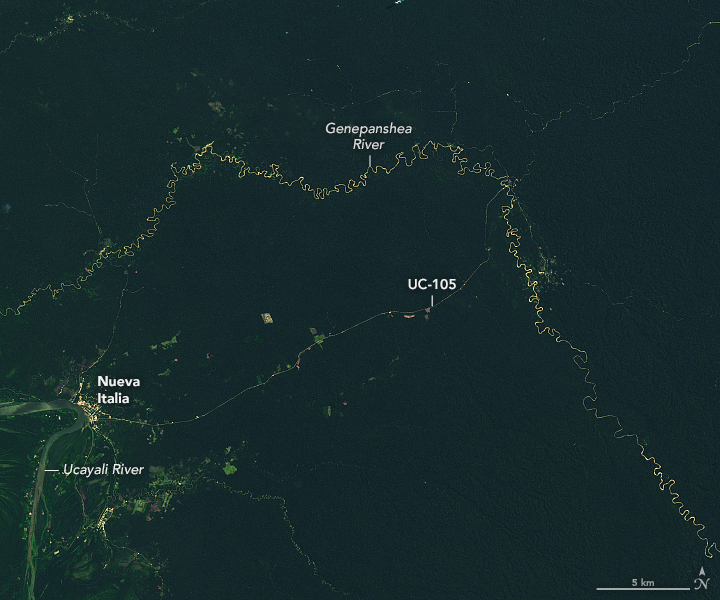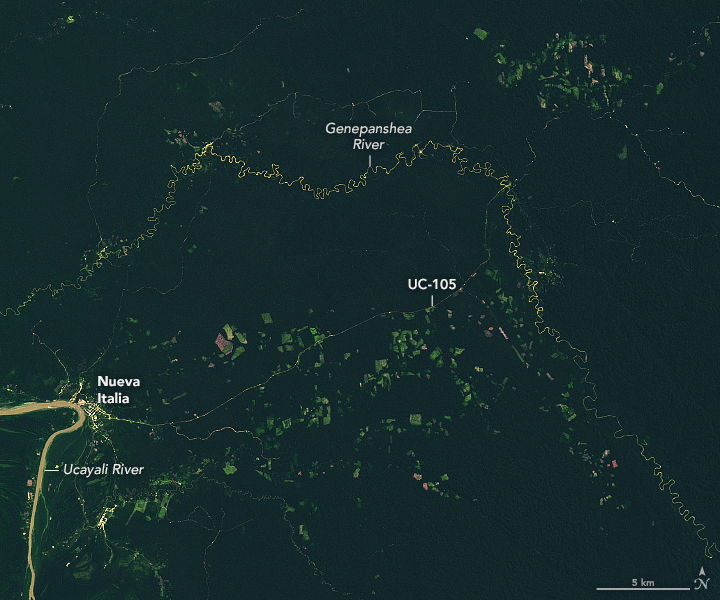IB Syllabus focus:
‘Greater diversity generally increases resilience and stability through succession; human interference can reduce both.’
Resilience and diversity are central themes in ecology, determining how ecosystems respond to disturbance. Human activities often undermine these qualities, destabilising natural processes and diminishing long-term ecosystem functioning.
Ecological Resilience
Resilience is the capacity of an ecosystem to recover after disturbance and return to its original state. Ecosystems with high resilience can absorb shocks without undergoing permanent change.

Ball-and-valley schematic illustrating stability landscapes: deep valleys represent more resilient states requiring larger perturbations to shift; shallow valleys depict low resilience and easier regime shifts. This conceptual model aligns with ecological resilience without exceeding the syllabus detail. Source.
Key Features of Resilient Ecosystems
High species diversity, offering redundancy in ecological roles.
Complex food webs that buffer against species loss.
Presence of keystone species, which disproportionately stabilise communities.
Healthy nutrient cycles and energy flows maintaining productivity.
Adapted species with wide ecological niches, enhancing flexibility.
Resilience: The ability of an ecosystem to resist, absorb, or recover from disturbance and maintain essential structure and processes.
Resilience is not uniform; some ecosystems, like tropical rainforests, are highly resilient, while others, such as tundra, are more fragile.
Biodiversity and Stability
Biodiversity underpins ecological stability by increasing the range of functions and interactions within a community. Diverse systems spread risk: if one species declines, others may fill its role.
How Diversity Enhances Stability
Genetic diversity provides populations with adaptive potential against disease or environmental change.
Species diversity ensures functional redundancy, strengthening food webs.
Habitat diversity supports more niches, reducing competition intensity.
Biodiversity: The variability among living organisms at genetic, species, and ecosystem levels within a given area.
Greater biodiversity usually correlates with higher resilience, but the relationship is context-dependent and influenced by disturbance type and intensity.
Succession and Resilience
Succession increases resilience over time as ecosystems mature. Early seral stages are more vulnerable, while later stages feature greater stability due to enriched soils, increased biomass, and complex species interactions.

Diagram of forest succession from early seral to mature communities, with accompanying curves showing increases in biomass, species diversity, and soil depth over time. The curves extend beyond the minimum syllabus wording but help visualise why later stages are typically more resilient. Source.
Features of Later Successional Stages
Deep, nutrient-rich soils.
High biomass and productivity.
Complex trophic interactions.
Increased species richness.
These qualities enhance resilience, making climax or stable communities less susceptible to collapse.
Human Activity and Reduced Resilience
Human actions frequently diminish both diversity and resilience, destabilising ecosystems. Common pressures include:

August 23, 2017

August 21, 2022
Paired Landsat images from Ucayali, Peru (2017 vs 2022) show rapid, road-associated deforestation. The real-world pattern demonstrates how human disturbance fragments habitats and erodes ecosystem resilience; minor geographic specifics exceed syllabus scope but aid interpretation. Source.
Deforestation: removes keystone species, disrupts nutrient cycles, and reduces habitat diversity.
Monoculture agriculture: lowers genetic and species diversity, increasing vulnerability to pests and diseases.
Pollution: stresses ecosystems, often leading to species loss.
Climate change: accelerates disturbances, overwhelming ecosystems’ adaptive capacities.
Overexploitation: reduces population sizes below recovery thresholds, decreasing functional redundancy.
These pressures reduce resilience by simplifying food webs, eroding genetic diversity, and increasing ecosystem fragility.
Human Impacts on Biodiversity
Human activity often results in reduced biodiversity, directly undermining ecosystem stability.
Examples of Biodiversity Loss
Habitat destruction: urbanisation, agriculture, and infrastructure fragment ecosystems.
Invasive species: outcompete native species, simplifying communities.
Unsustainable harvesting: removes key species from ecosystems.
Loss of biodiversity diminishes the ability of ecosystems to recover, leaving them more vulnerable to tipping points and regime shifts.
Feedback Loops and Instability
Resilience depends on negative feedback loops that regulate populations and maintain equilibrium. Human interference often disrupts these processes.
Examples
Overfishing: removes predators, causing prey populations to boom and crash.
Deforestation: reduces evapotranspiration, altering rainfall and destabilising local climates.
Such disruptions weaken natural feedbacks, reducing both stability and resilience.
Conservation and Human Responsibility
Although human activity reduces resilience and diversity, management strategies can help reverse or mitigate impacts:
Protected areas: preserve biodiversity and ecosystem functions.
Restoration ecology: reintroduces species, rehabilitates habitats, and restores nutrient cycles.
Sustainable land use: promotes crop rotation, agroforestry, and mixed farming to enhance resilience.
Climate action: limits warming, protecting ecosystems from excessive stress.
Conservation: The sustainable management of natural resources to maintain biodiversity and ecological integrity for present and future generations.
Such strategies enhance resilience by maintaining diversity and supporting ecological processes.
Linking Diversity, Resilience, and Human Impact
The IB specification highlights that greater diversity generally increases resilience and stability through succession; human interference can reduce both. This relationship forms a central theme in understanding human–environment interactions. Diversity and resilience reinforce each other, but both are highly susceptible to human-driven change, requiring urgent and deliberate management to safeguard ecosystems.
FAQ
Functional redundancy occurs when multiple species perform similar ecological roles. If one species is lost, others can maintain the same function, supporting recovery.
For example, several plant species may provide nectar for pollinators. Losing one species may not collapse the pollinator population if alternatives exist. This redundancy increases stability and reduces the likelihood of ecosystem collapse.
Keystone species exert a disproportionate influence on community structure. Their removal can trigger cascading effects that dramatically reduce resilience.
For instance, the loss of a top predator may allow herbivore populations to expand unchecked, leading to vegetation loss and reduced biodiversity. Protecting keystone species therefore enhances both diversity and stability.
High diversity usually strengthens resilience, but excessive overlap of niches can lead to intense competition. This may destabilise populations rather than strengthen them.
However, in most cases natural limits such as resource availability prevent ecosystems from reaching unsustainably high diversity. The relationship is therefore not linear but tends to plateau at a point where diversity supports stability without major conflict.
Resilience is influenced by both the type and frequency of disturbance. Occasional small disturbances can maintain diversity by preventing dominance of one species.
However, disturbances that are too frequent or intense can outpace recovery capacity, reducing both diversity and resilience. Balancing natural disturbance cycles is therefore key to sustaining stable ecosystems.
Habitat fragmentation isolates populations into smaller groups, making them more vulnerable to local extinction and genetic bottlenecks.
Smaller populations have reduced genetic diversity.
Movement of species between patches is restricted.
Edge effects increase stress and reduce core habitat quality.
Together, these changes decrease ecosystem stability and limit the ability to recover after disturbance.
Practice Questions
Question 1 (2 marks)
Define the term resilience in an ecological context.
Mark Scheme:
1 mark for stating that resilience refers to the ability of an ecosystem to resist, absorb, or recover from disturbance.
1 mark for including that essential structure and processes are maintained or restored.
Question 2 (5 marks)
Explain how biodiversity contributes to ecological resilience, and discuss how human activities may reduce both biodiversity and resilience.
Mark Scheme:
Up to 2 marks for explaining how biodiversity contributes to resilience:
(1 mark) Species diversity provides redundancy in ecological roles.
(1 mark) Genetic diversity increases adaptability to change or disease.
Up to 2 marks for describing human impacts reducing biodiversity and resilience:
(1 mark) Example of human activity (e.g. deforestation, monoculture agriculture, overexploitation, pollution).
(1 mark) Explanation of how the activity reduces diversity/resilience (e.g. simplifies food webs, reduces genetic variability).
1 mark for a linked discussion that connects loss of biodiversity with reduced resilience (e.g. fewer species means ecosystems recover more slowly after disturbance).

